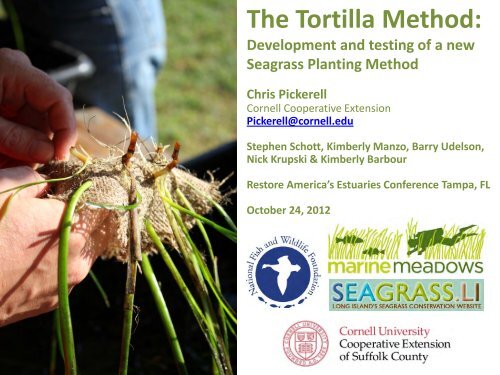The Tortilla Method: - Restore America's Estuaries
The Tortilla Method: - Restore America's Estuaries The Tortilla Method: - Restore America's Estuaries
The Tortilla Method: Development and testing of a new Seagrass Planting Method Chris Pickerell Cornell Cooperative Extension Pickerell@cornell.edu Stephen Schott, Kimberly Manzo, Barry Udelson, Nick Krupski & Kimberly Barbour Restore America’s Estuaries Conference Tampa, FL October 24, 2012
- Page 2 and 3: Outline • Seagrass Transplanting
- Page 4 and 5: An Effective Transplant Method o In
- Page 6 and 7: How the Method was Developed Follow
- Page 8: Stocking the Tortillas
- Page 15 and 16: The “Tortilla Method” Details S
- Page 17: Paradise Pt photo
- Page 22 and 23: Making Tortillas
- Page 24 and 25: Making Tortillas
- Page 26: Workshops
- Page 30 and 31: Advantages of the Method • Has dr
- Page 32: Questions?
<strong>The</strong> <strong>Tortilla</strong> <strong>Method</strong>:<br />
Development and testing of a new<br />
Seagrass Planting <strong>Method</strong><br />
Chris Pickerell<br />
Cornell Cooperative Extension<br />
Pickerell@cornell.edu<br />
Stephen Schott, Kimberly Manzo, Barry Udelson,<br />
Nick Krupski & Kimberly Barbour<br />
<strong>Restore</strong> America’s <strong>Estuaries</strong> Conference Tampa, FL<br />
October 24, 2012
Outline<br />
• Seagrass Transplanting Basics<br />
• How the <strong>Tortilla</strong> <strong>Method</strong> evolved from other<br />
methods we have used<br />
• Details of the <strong>Method</strong>ology<br />
• Scaling-Up and Integrating Volunteers<br />
• Comparison of our <strong>Method</strong> to another<br />
<strong>Method</strong>
Seagrass Transplanting Basics<br />
o Site Selection (WQ, Sed., Light, Temp, etc.)<br />
o Transplant stock (healthy, adapted, etc.)<br />
o Time of year<br />
o Must anchor the plants in or on the bottom until they become<br />
established (weeks to months)
An Effective Transplant <strong>Method</strong><br />
o Inexpensive<br />
o Simple to use<br />
o Not overly Labor Intensive<br />
o Compatible with different site<br />
conditions<br />
o Is scalable<br />
o Not susceptible to bioturbation or<br />
erosion loss<br />
o Ideally does not require follow up<br />
maintenance, etc.<br />
o Holds the plants (Anchors them) on<br />
the bottom for at least 2 weeks<br />
From: Kun-Seop Lee & Jung-Im Park “An effective<br />
transplanting technique using shells for restoration of<br />
Zostera marina habitats”
Things to consider for anchors<br />
o Less is better<br />
o Hard structures will cause turbulence<br />
o Hard structures will attract crabs<br />
o Hard structures can be heavy and<br />
cumbersome<br />
o <strong>The</strong> best systems are below the<br />
sediment surface<br />
o Horizontal Rhizome <strong>Method</strong><br />
o Staple <strong>Method</strong><br />
o Wooden Stakes<br />
o Etc.
How the <strong>Method</strong> was Developed<br />
Following the success of our “Rock Planting” method we<br />
decided to try to expand the concept to sites without rocks.<br />
After dismissing the thought of moving rocks we developed<br />
a system that used burlap sandbags as “rocks”.<br />
In addition to being very labor intensive we learned that<br />
the sandbags actually caused more harm then good by<br />
causing excessive erosion in high current areas.<br />
To avoid this problem we started to bury the sand bags<br />
during planting…we soon realized the bag was not<br />
necessary if the plants could be planted within the<br />
sediment
<strong>The</strong> <strong>Tortilla</strong> <strong>Method</strong> Components
Stocking the <strong>Tortilla</strong>s
Planting <strong>Tortilla</strong>s
<strong>The</strong> “<strong>Tortilla</strong> <strong>Method</strong>” Details<br />
Single PU<br />
Test Plot (10)<br />
Small Patch (50)
Test Plots<br />
1m<br />
1m<br />
Test Plot (10PU’s = 100 plants)<br />
Test Plot (5PU’s = 50 plants)<br />
3m<br />
Test Plot Transect (50PU’s = 500 plants)<br />
(25PU’s = 250 plants)
Paradise Pt photo
Scaling-Up/Integrating Volunteers<br />
This system clearly reduces labor/time in the water (SCUBA) but<br />
at the same time requires more labor above water.<br />
Part of this involves making the tortillas the other part involves<br />
stocking/weaving the plants into the tortillas.<br />
To respond to these needs we have created a new volunteerbased<br />
program called “Marine Meadows”<br />
Over the last 1.5yrs. this program has been a tool for education,<br />
outreach and even fundraising.
Making <strong>Tortilla</strong>s
Making <strong>Tortilla</strong>s
Making <strong>Tortilla</strong>s
Workshops
Workshops
Value Added Benefits<br />
Creation of a new volunteer-based<br />
program<br />
Increased visibility and buy-in<br />
(politicians, resource managers,<br />
educators, the press, citizens, children,<br />
etc.)<br />
Increased public and private funding<br />
opportunities
Advantages of the <strong>Method</strong><br />
• Has drastically reduced bottom time (SCUBA hrs)<br />
for plantings.<br />
• Increased the number and scale of plantings we<br />
are able to complete in the same time.<br />
• Less time in the water during late fall and early<br />
winter makes for happier divers!<br />
• Has allowed for development of a new public<br />
outreach and education component to our efforts<br />
(increased visibility, increased funding, etc.)
How does this method compare?<br />
Salem Harbor, MA plantings (Tay Evans, Mass Division of Marine Fisheries)<br />
200%<br />
eelgrass % survival<br />
180%<br />
160%<br />
140%<br />
120%<br />
100%<br />
80%<br />
60%<br />
40%<br />
HR - shallow<br />
T - shallow<br />
HR - deep<br />
T - deep<br />
20%<br />
0%
Questions?



